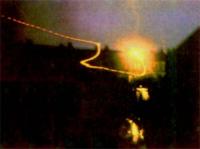Fluctuating magnetic fields, created by a nearby lightning bolt, could trick the brain into "seeing" round glowing objects, explaining at least some observations of mysterious 'ball lightning'.
The phenomenon is often described as a hovering orb of light – smaller than a beach ball – that lasts for a few seconds or minutes. It is thought to occur when lightning strikes the ground, but its exact cause is not clear.
Now it seems the glowing blobs may be a hallucination. Moving charges, in lightning strikes or in wire coiled around a patient's head, generate magnetic fields. A fluctuating magnetic field induces an electric field that, if powerful enough, can make neurons fire in the visual cortex. Pale ovals, bubbles, lines, or patches are sometimes observed by patients who undergo transcranial magnetic stimulation (TMS).
During a lightning storm, the initial stroke towards Earth is so short that we wouldn't have time to react to it – two to three millionths of a second. After it hits the ground, a return stroke, which carries some of the charge back into the sky with a thunder-causing shockwave, lasts around 0.2 milliseconds – very near the shortest duration of the clinical stimulation.
A single flash generates an average of two to five return strokes. But some strikes can create more than 20 – a protracted stream of events that could produce hallucinations lasting for multiple seconds, according to calculations by Josef Peer and Alexander Kendl, both of Innsbruck University in Austria.
In order to feel the effects of the magnetic field – but not be injured – a person would need to be 20 to 200 metres from the strike location, the researchers say. They estimate that in one per cent of close-lightning experiences, the fluctuating magnetic field could produce a hallucination in an observer.
"To our surprise, the results from long, repetitive pulses matched TMS fields astonishingly well," says Kendl.
They estimate that such apparitions account for about half of all ball lightning sightings. Hallucinations would explain how a fireball could apparently drift through a wall or window and leave it unharmed.
"The general notion that the electromagnetic fields of lightning might [affect] neural tissue is an interesting issue," says Thomas Kammer of Germany's University of Ulm, who advised the team on the neurobiological aspects of the work.
Kammer notes that the strong electromagnetic field is likely to cause neurons in the eye's retina to fire before those in the visual cortex, since retinal neurons are sensitive to weaker electric fields. But it's not clear whether this would make observers even more likely to hallucinate ball lightning, since the visual effects that retinal neurons produce are not well understood.
However, he doubts that sightings of ball lightning lasting longer than a few seconds can be explained by TMS hallucinations, since even repetitive return strokes don't last very long.
What's more, the serious burns and deaths attributed to ball lightning need a material explanation.
Plasma research suggests that dust-gas fireballsMovie Camera may be produced in a strike that hits sandMovie Camera or water.
And "ball lightning" that doesn't drift may be Saint Elmo's fire – a glowing plasma of excited electrons generated around the tops of pointed objects, such as a steeple or a ship's mast.
"New Scientist"
26 Декабря 2025 | пятница | 22:10


